On the network shown in the figure, IS-IS runs on R1, R2, R4, and R5, and the area ID is 49.0001. IS-IS runs on R3 and R6, and the area ID is 49.0002. The import-route isis level-2 into level-1 command is configured on R2 and R5. In AS 65000, R1, R3, R4, and R6 each establish iBGP peer relationships with R2 and R5. R2 and R5 are RR (Route Reflectors), and R1, R4, R3, and R6 are the iBGP peer relationship clients. The iBGP peer relationship ID is 10.0.0.X/32, where X is the number of the iBGP router. R1 and R4 import the external route 192.168.1.0/24 to BGP through the import-route command, and R3 and R6 import the external route 192.168.2.0/24 to BGP through the import-route command. Which of the following statements are true?
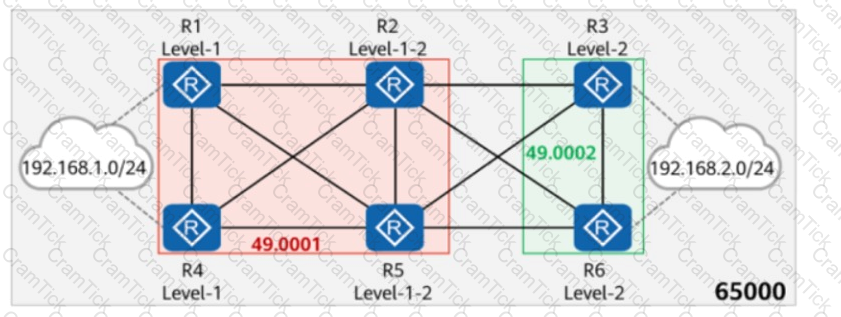
During an attempt to log in to a NetEngine AR6120 through the console port, the network engineer finds that the password is incorrect and the login fails. If a Telnet account can be used to log in to the device and the account has the permission to change the console port password, the network engineer can log in to the device through Telnet to change the console port password.
On the network shown in the figure, IS-IS IPv6 runs on R2, R6, and R3, and the IPv6 address of Loopback0 on R6 is 2000::6/128. OSPFv3 runs on other links. Area 1 is a stub area, and Area 2 is an NSSA. IS-IS routes are imported to OSPFv3 on R2 and R3. Which of the following statements are true?
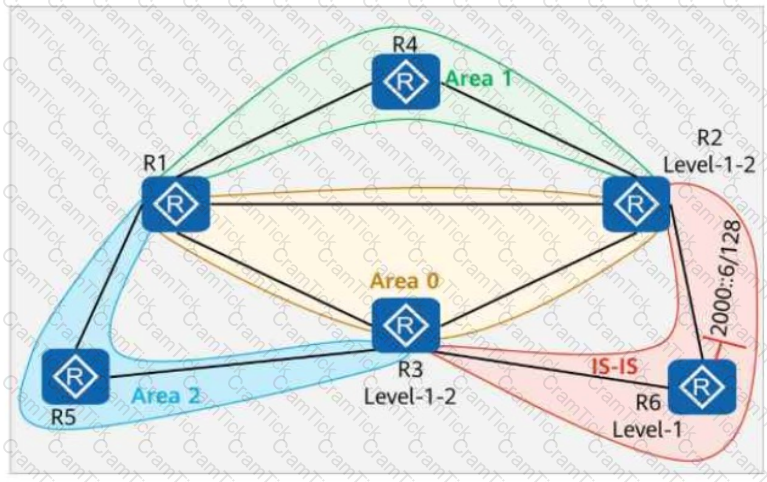
If the display ospfv3 peer verbose command is run to check OSPFv3 neighbor information, the command output contains information such as the peer router ID, global unicast address of the peer interface, and neighbor status.
VLAN aggregation is configured on a switched network. Sub-VLAN 2 and Sub-VLAN 3 are added to Super-VLAN 10. To enable hosts in different sub-VLANs to communicate with each other, run the following command in the VLANIF 10 view corresponding to the Super-VLAN.
(Enter lowercase letters.)
MPLS can carry multiple network protocol services, including unicast IPv4 services, multicast IPv4 services, unicast IPv6 services, and multicast IPv6 services.
On the network shown in the figure, EBGP peer relationships are established between neighboring routers through directly connected interfaces.
The router ID of each router is 10.0.X.X, and the AS number is 6500X, where X is the number of the router.
Both R1 and R4 have static routes to 192.168.1.0/24, which are imported to BGP through the import-route command.
The aggregate 192.168.1.0/16 detail-suppressed command is configured on R2.
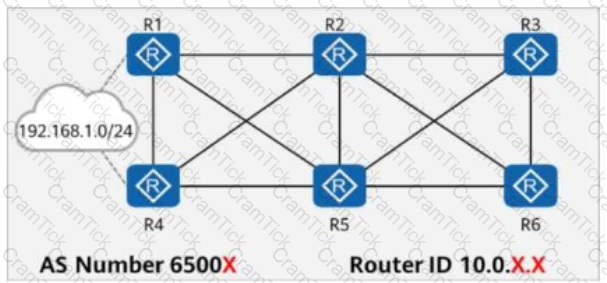
Which of the following is the path for traffic from R3 to 192.168.1.0/24?
As its network scale expands, an enterprise plans to move scattered servers to the same equipment room for unified management. During hardware migration, network engineers do not need to perform device commissioning and therefore do not need to work out a migration solution.
A network device has established an OSPF neighbor relationship with another device. The figure shows the configuration of GE0/0/0 on the network device.
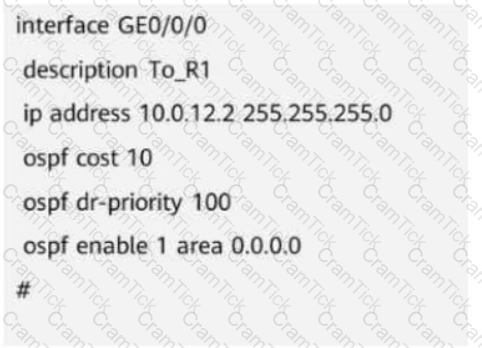
Which of the following commands would NOT affect the OSPF neighbor status of the interface?
An administrator runs the display mpls lsp command to view LSPs on a device. The command output is shown in the figure.
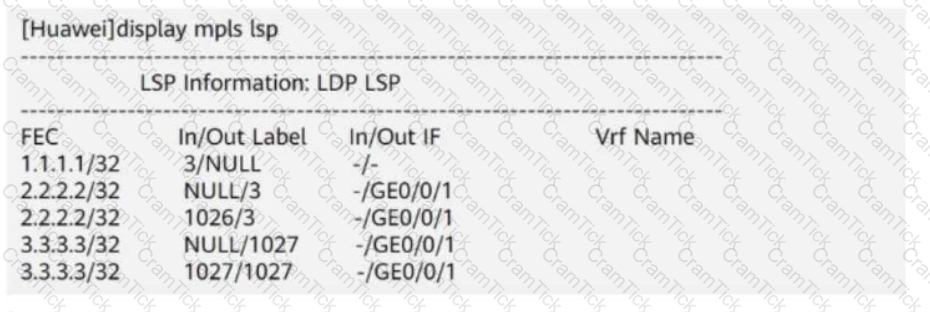
Which of the following statements is true?
Options:
The figure shows the file information on R2. When a network engineer runs the dir | exclude 1 command to view the file information, which of the following files will be displayed?
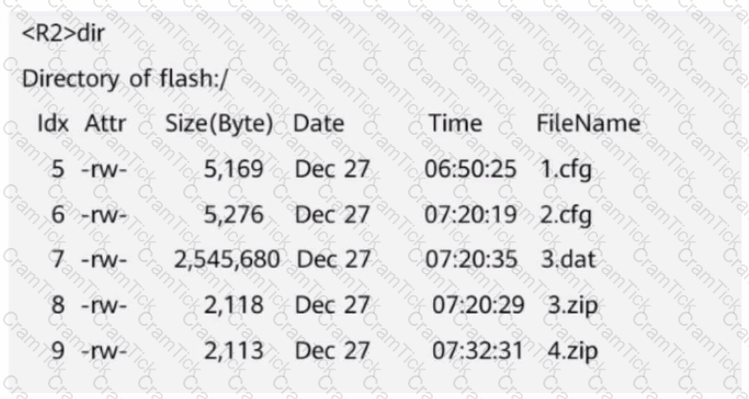
Both VLAN aggregation and MUX VLAN are deployed on the enterprise network shown in the figure, and all switch interfaces connected to terminals are access interfaces. Given this, match PCI to PC4 with the hosts or servers that they can access on the network. (Note: A host cannot be matched with itself. For example, PCI cannot match PCI.) (Tokens can be reused.)
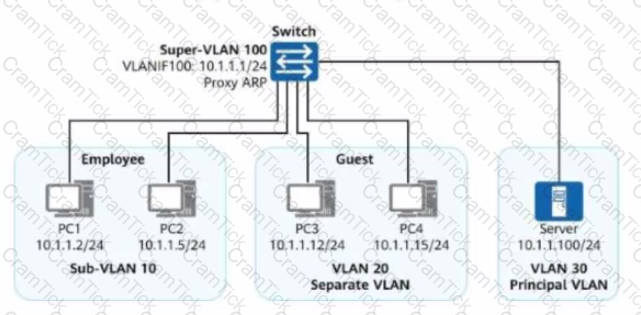
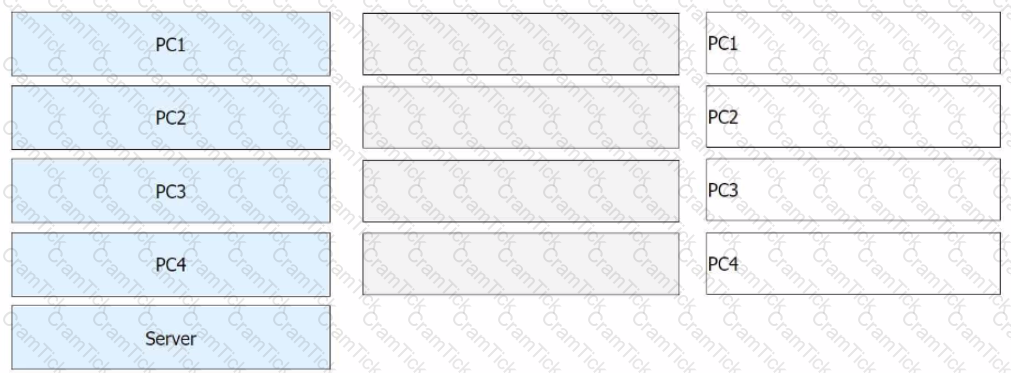
On the network shown in the figure, VRRP is configured on Rl and R2, and the virtual IP address is 10.0.12.254. After the configuration is complete, the network engineer checks the VRRP status on R1 and R2, and finds that both devices are in the Master state. Which of the following is not a possible cause of this problem?

On the OSPF network shown in the figure, drag the values on the left to the correct positions so that:
Traffic from PC1 to PC2 follows the path:PC1 -> R1 -> R3 -> R2 -> PC2
Traffic from PC2 to PC1 follows the path:PC2 -> R2 -> R1 -> PC1
Which of the following OSPF cost values should be assigned to Cost-A, Cost-B, and Cost-C to achieve this routing behavior?
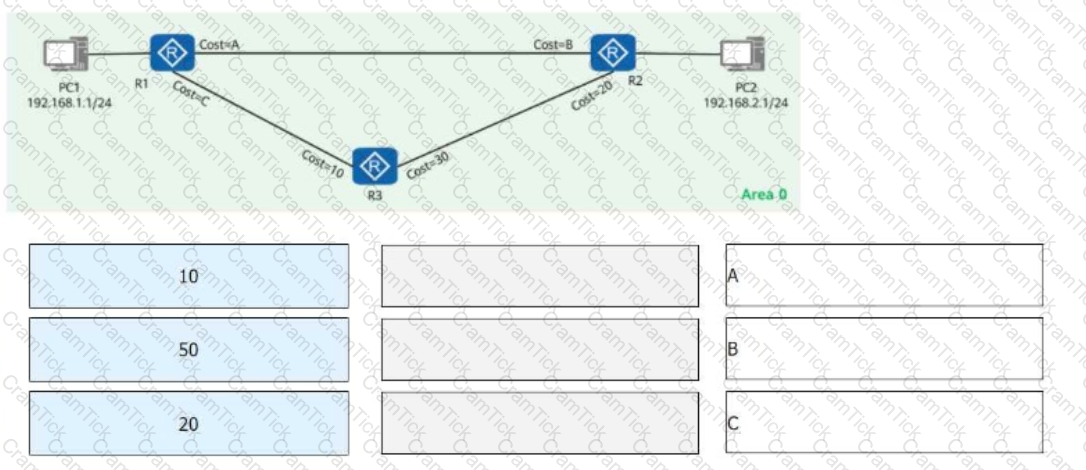
BFD for OSPF refers to the association of BFD with OSPF to speed up OSPF's response to network topology changes. The OSPF neighbor relationship can enter the Full state only after the BFD session goes up. The OSPF neighbor relationship can go down only after the BFD session goes down.
A network engineer provides a troubleshooting report after rectifying a fault. The actual network is simplified into the one shown in the figure, where R1 and R2 both have OSPF enabled and function as the gateways of PC1 and PC2, respectively.
Given this, which of the following statements are true?

Network Topology:
R1:
Interface GE0/0/0: 10.0.12.1/24 (Connected to R2)
Interface GE0/0/1: 192.168.1.1/24 (Gateway for PC1)
R2:
Interface GE0/0/0: 10.0.12.2/24 (Connected to R1)
Interface GE0/0/1: 192.168.1.2/24 (Gateway for PC2)
Options:
On the OSPFv3 network shown in the figure, area 1 is a stub area, area 2 is a common area, and area 3 is an NSSA. Which of the following LSAs is displayed only in area 2?
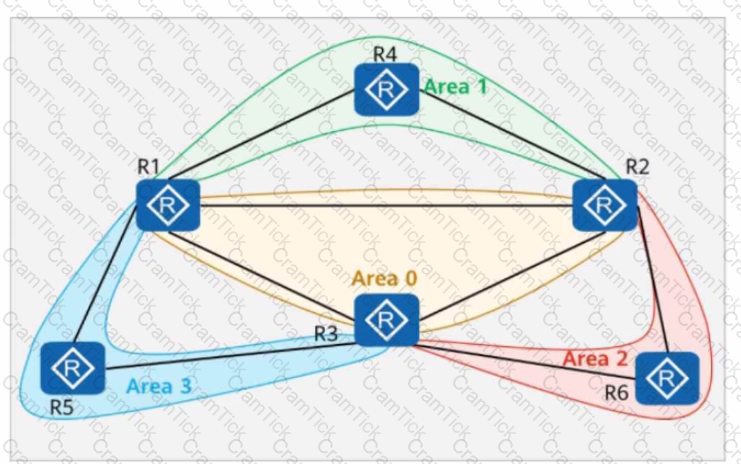
To protect a device against the attacks of forged BGP messages, you can configure GTSM to check whether the TTL value in the IP message header is within the specified range. If the peer x.x.x.x valid-ttl-hops 100 command is configured on a device, the valid TTL value range of the detected message is [155, 255].
If the migration preparation is insufficient, which of the following problems may occur?
Options (Multiple Choice):
On the OSPFv3 network shown in the figure:
Area 1 is a stub area
Area 2 is a common area
Area 3 is an NSSA
The IPv6 address of Loopback0 on R6 is 2000::6/128.
The router ID of each router is 10.0.X.X, where X is the router number.
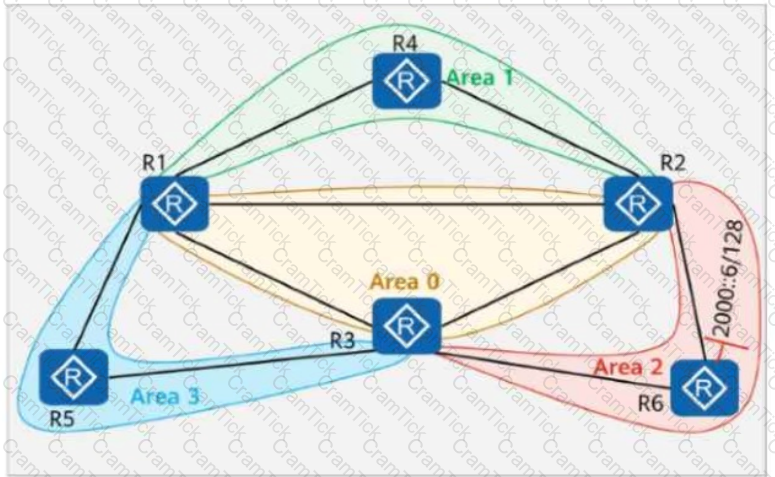
Which of the following statements are true?
On the network shown in the figure, IS-IS runs on Rl, R2, R4, and R5, and the area ID is 49.0001. IS-IS runs on R3 and R6, and the area ID is 49.0002. In AS 65000, Ri, R3, R4, and R6 each establish IBGP peer relationships with R2 and R5. R2 and R5 are RRs, and Rl, R4, R3, and R6 are clients. The IBGP peer relationships are established using LoopbackO. The IP address of LoopbackO on each router is 10.0.X.X/32, and the router ID is 10.0.X.X, where X is the number of the router. Rl and R4 import the external route 192.168.1.0/24 to BGP through the import-route command, and R3 and R6 import the external route 192.168.2.0/24 to BGP through the import-route command. Which of the following statements are true?
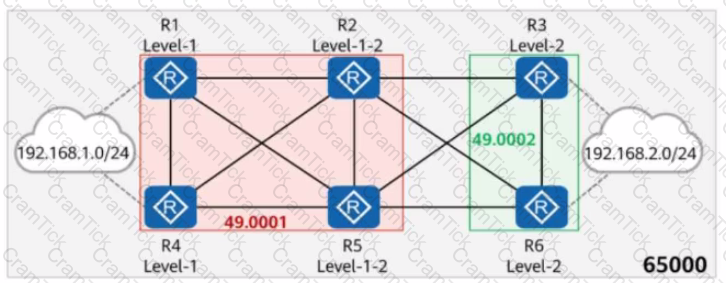
On an MPLS network, after an LSR receives a Hello message from a peer, the LSR establishes an LDP adjacency with the peer. The Hello message is sent in multicast or unicast mode.
On the OSPFv3 network shown in the figure, the LSDB (Link-State Database) of R2 contains ______ Router-LSAs. (Enter only digits.)

After port isolation is configured on a switch, hosts in the same VLAN cannot communicate with each other at Layer 2 or Layer 3 by default.
On the network shown in the figure, EBGP peer relationships are established between neighboring routers through directly connected interfaces.
The router ID of each router is 10.0.X.X, and the AS number is 6500X, where X is the number of the router.
Both R1 and R4 have static routes to 192.168.1.0/24, which are imported to BGP through the import-route command.
R1 adds a community attribute (1:1) to the route before advertising it to its peers.
All routers are configured to propagate community attributes.
R3 is configured with a routing policy that rejects routes with the community attribute 1:1.
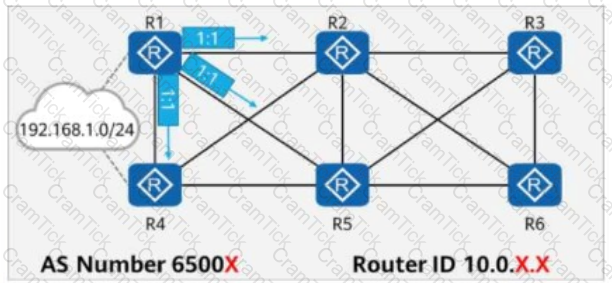
In this case, which of the following is the path for traffic from R3 to 192.168.1.0/24?
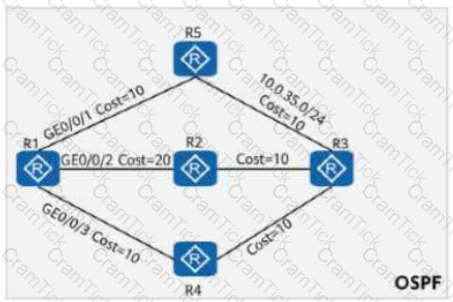
On the OSPF network shown in the figure, the cost values of links are marked. OSPF IP FRR is enabled on R1, and the maximum load-balancing 8 command is configured in the OSPF process. Which of the following is the cost value of the route 10.0.35.0/24 in the routing table of R1?
An interface of a switch is in error-down state. A possible cause is that the average rate of broadcast packets received by the interface exceeds the upper threshold set by the administrator for storm control.
In CE multi-homing scenarios, if BGP AS number substitution is enabled on PEs, you can run the peer soo command on the EBGP peers of the PEs and CE to configure the Site of Origin (SoO) attribute to prevent loops.
In the figure, packets are forwarded based on MPLS on the network.
When PE2 receives a packet from P2, what is the label value carried in the packet?

Options:
On the OSPFv3 network shown in the figure, area 1 is an NSSA. R1 imports the external route 2000::1/128 to OSPFv3. Which of the following LSAs does not exist in area 1?
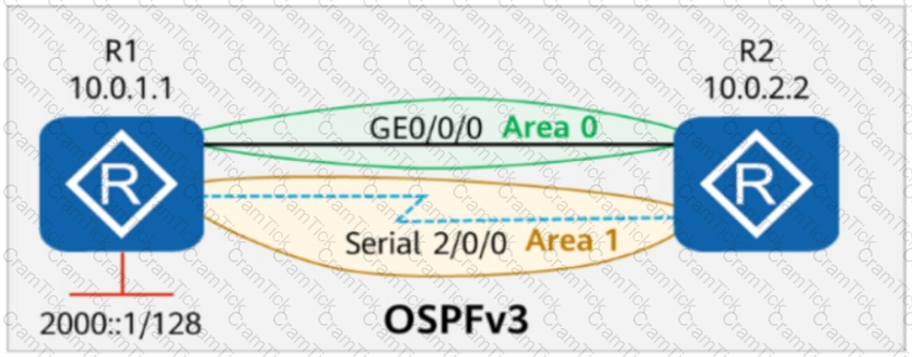
On a BGP/MPLS IP VPN network, which of the following are carried when a PE advertises VPNv4 routes?
On the network shown in the figure, EBGP peer relationships are established between ASs through directly connected interfaces.
OSPF is deployed in AS 65456 (with OSPF disabled on interconnected interfaces between ASs).
R4 and R5 use Loopback0 to establish iBGP peer relationships with R6.
The IP address of Loopback0 on each router is 10.0.X.X/32, and the router ID is 10.0.X.X, where X is the number of the router.
R1, R2, and R3 import the external route 192.168.1.0/24 into BGP through the import-route command.
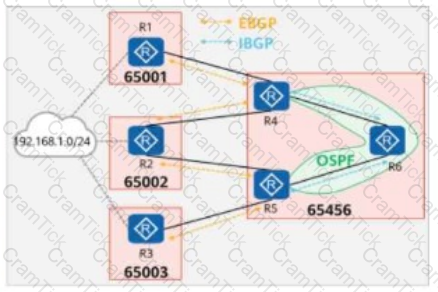
Which of the following statements are true?
When an IP packet passes through an MPLS network, an MPLS device processes the TTL value in the packet.
If the pipe mode is used in the topology shown in the figure, which of the following is the TTL value in the IP packet?
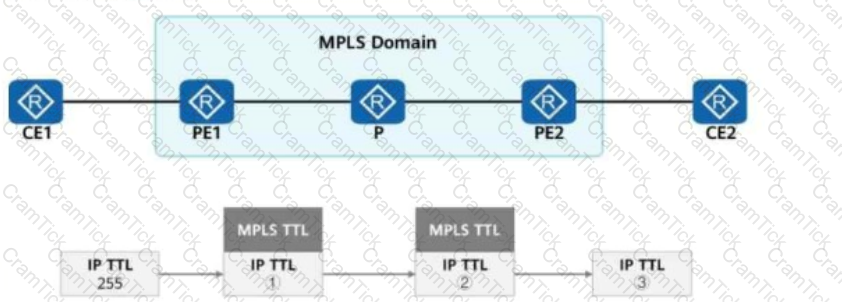
Options:
On the OSPF network shown in the figure, the cost values of links are marked. OSPF IP FRR is enabled on R1. The primary path from R1 to 10.0.3.3/32 is R1 -> R2 -> R3, and the backup path is R1 -> R4 -> R2 -> R3.
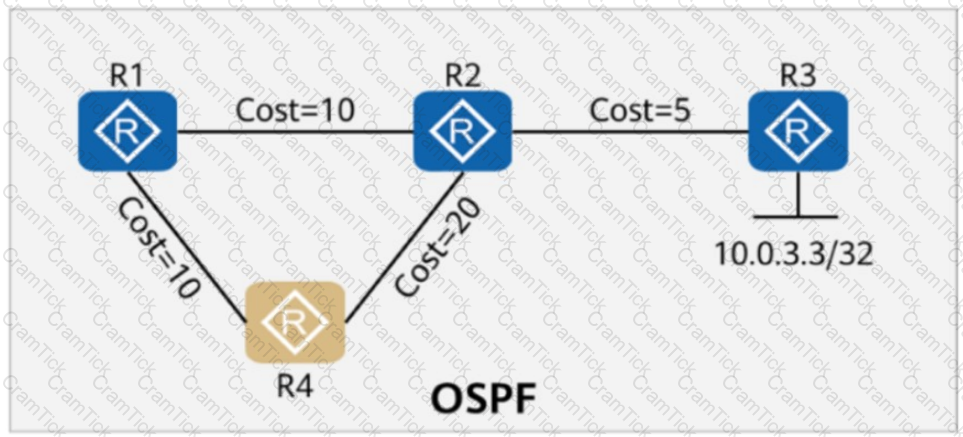
On a stable network that requires fast route convergence, you can change the value of the interval at which OSPF LSAs are updated to 0 so that topology or route changes can be immediately advertised on the network through LSAs, which speeds up route convergence.
The figure shows the LSP information of R1 and R3 on an MPLS network. An administrator runs the ping -a 1.1.1.1 3.3.3.3 command on R1. Given this, which of the following statements is true?
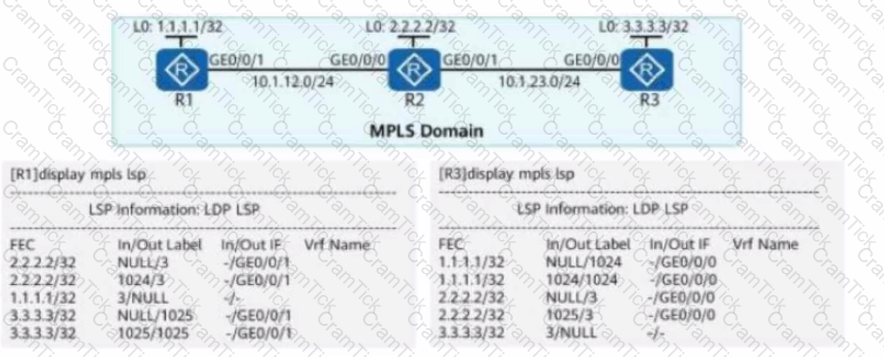
On the OSPFv3 network shown in the figure, area 1 is a common area. Which of the following statements are true?
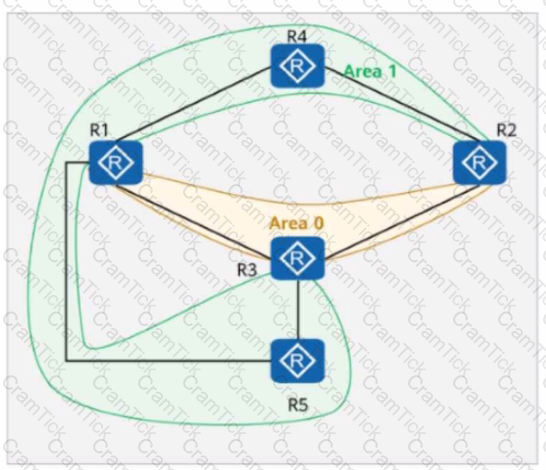
On the network shown in the figure, a network engineer finds that the path between PC1 and PC2 is not the optimal path, and all links along the path have the same cost.
Given this, which of the following routers may be the root bridges of the Layer 2 network?
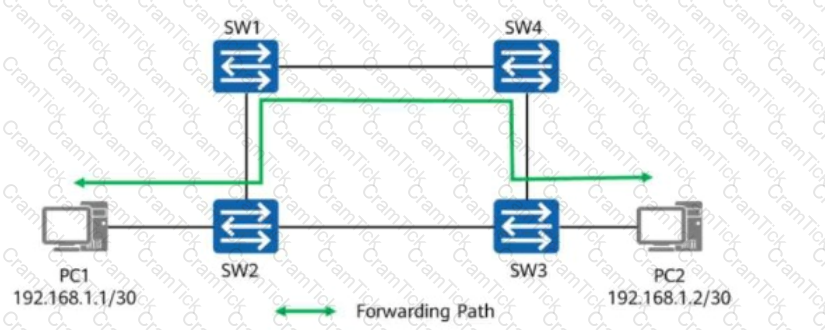
Options:
The figure shows information about an LSP (Link-State PDU) generated by an IS-IS router.
From the LSP, you can infer that the router is not the DIS (Designated Intermediate System) of the local link.
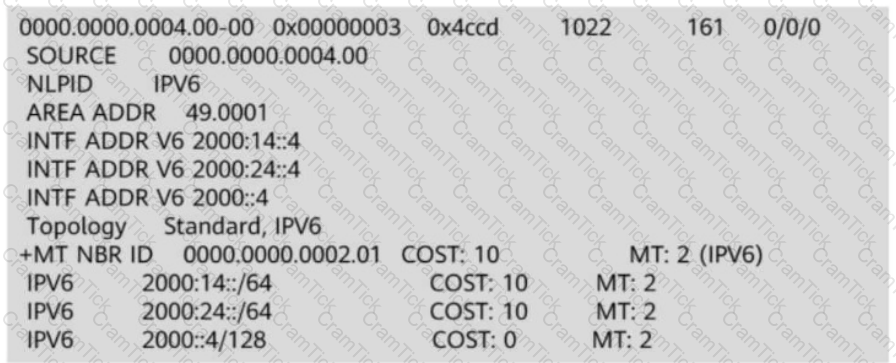
Options:
On an MPLS network, when a transit device receives an MPLS packet and is ready to swap labels, it finds that the label value after swapping is 0. In this case, which of the following operations will the device perform?
Options:
On the enterprise network shown in the figure, R3 is connected to the NMS, and all devices on the network communicate with the NMS through a VPN.
During an inspection, it is found that R3 has redundant RTs (Route Targets).
Which of the following commands can be run on R3 to delete the redundant RTs without affecting the connectivity between all devices and the NMS?
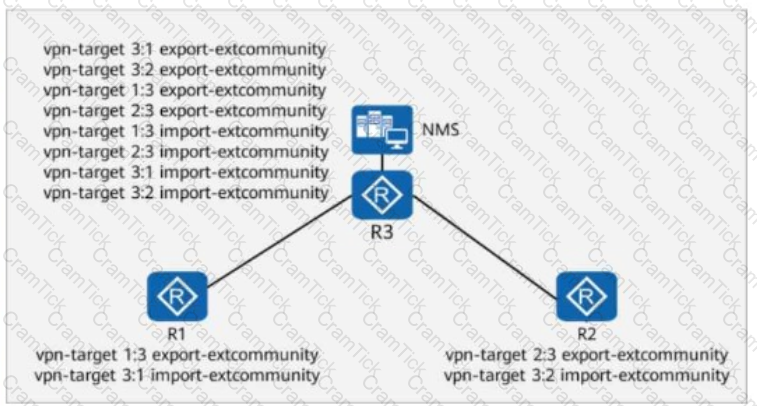
Options:
On the OSPFv3 network shown in the figure:
Area 1 is a stub area, Area 2 is a common area, and Area 3 is an NSSA (Not-So-Stubby Area).
The IPv6 address of Loopback0 on R6 is 2000::6/128.
The router ID of each router is 10.0.X.X, where X is the router number.
The stub no-summary command is configured in Area 1 on R2.
Which of the following statements is true?
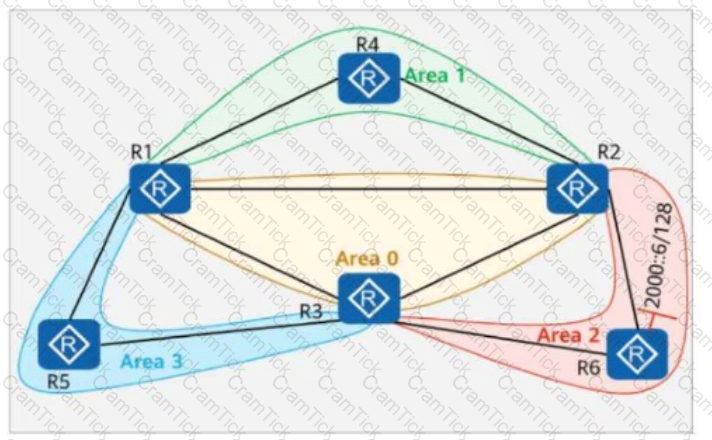
On the network shown in the figure, IS-IS runs on R1, R2, R4, and R5, and the area ID is 49.0001. IS-IS runs on R3 and R6, and the area ID is 49.0002. In AS 65000, R1, R3, R4, and R6 each establish iBGP peer relationships with R2 and R5. R2 and R5 are RRs (Route Reflectors), and R1, R4, R3, and R6 are clients. The iBGP peer relationships are established using Loopback0 on each router, and the router ID is 10.0.0.X/32, where X is the number of the router. R1 and R4 import the external route 192.168.1.0/24 to BGP through the import-route command, and R3 and R6 import the external route 192.168.2.0/24 to BGP through the import-route command. Which of the following statements are true?
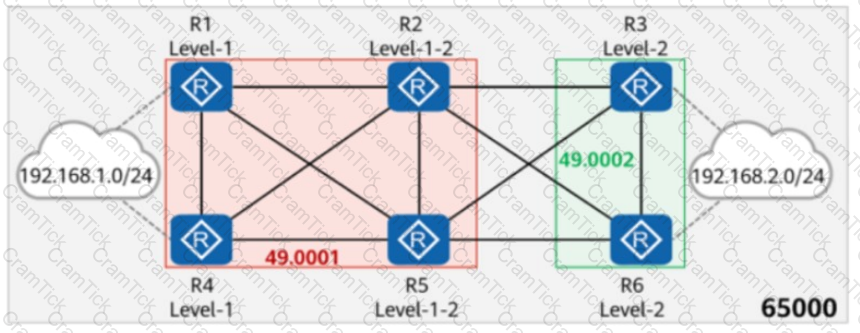
HCIP-Datacom | H12-831_V1.0 Questions Answers | H12-831_V1.0 Test Prep | HCIP-Datacom-Advanced Routing & Switching Technology V1.0 Questions PDF | H12-831_V1.0 Online Exam | H12-831_V1.0 Practice Test | H12-831_V1.0 PDF | H12-831_V1.0 Test Questions | H12-831_V1.0 Study Material | H12-831_V1.0 Exam Preparation | H12-831_V1.0 Valid Dumps | H12-831_V1.0 Real Questions | HCIP-Datacom H12-831_V1.0 Exam Questions


